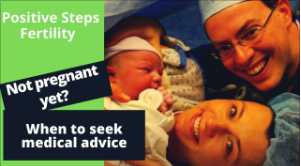A common concern we hear from many women is what if my eggs are no longer any good to conceive?
Though we never want eggs scrambled, as a society, we tend to focus too much on the ovaries that produce a woman’s eggs as the only issue in trying to conceive (TTC).
Far too often the overlooked part of the pregnancy process is what happens to these eggs after they are transported to the fallopian tube, where fertilization occurs. Additionally, the uterus, which nourishes and houses a fertilized egg until the baby is born, is just as relevant.
As you age, the number and quality of eggs you have in reserve diminishes.
According to the American Society for Reproductive Medicine, “The ovarian reserve refers to a woman’s fertility potential in the absence of any problems in the reproductive tract (fallopian tubes, uterus, vagina). It mainly depends on the number and quality of eggs in the ovaries and how well the ovarian follicles are responding to the hormonal signals from the brain.” https://www.asrm.org/topics/topics-index/ovarian-reserve/
On average, half of all highly fertile women (averaging eight children) not using contraception will conceive for the last time at the age of 40 to deliver a baby by 41. This fact makes 40 a much more concerning cutoff than 35. Even at 35, women are six times more likely to have subfertility (meaning that it’s taking longer than average to get pregnant) compared to a healthy 25-year-old (30% vs 5%).
To look at the numbers
- Generally speaking, in your 20’s, 80-90% of eggs are chromosomally normal.
- As you get into the early 30’s, maybe 2/3rds of eggs are healthy
- As you age to your mid to late 30’s, roughly 1/3rd of eggs may be of good quality.
- And by the time you reach your 40’s, your quality egg reserve may be reduced to a quarter or less.
- By 45, you can even see 90-95% of eggs to be chromosomally abnormal.
So, when looking at the eggs, age is one of the most critical aspects in calculating quantity versus quality.
- The more eggs you have available, the more likely there is
ahealthy one among them to initiate a pregnancy. - In contrast, the older we get, the lower the egg quantity and quality.
The number of healthy eggs a woman has (called ovarian reserve) diminishes with age, making pregnancy less likely. So, if you’re 45 and have one egg to choose from in a month but 90-95% are chromosomally abnormal, you might only release one healthy egg per year, which makes it harder to get pregnant.
When measuring ovarian reserve, the objective is to determine whether you can release a sufficient number of healthy eggs into the fallopian tubes.
How do you get your ovaries checked for fertility?
One factor of female fertility relates to the ovaries, where both releasing a healthy egg for fertilization and a woman’s “ovarian reserve” are determined.
Measuring ovarian reserve is a two-pronged approach involving lab work and ultrasound imaging for AFC (antral follicle count) testing (which we prefer).
If you are at a point where you want to conceive but haven’t, there are specific ovarian reserve fertility tests that can help you find answers.
Often, clinics will turn to a blood test called “FSH,” which is an abbreviation for follicle-stimulating hormone.
FSH – Follicle-Stimulating Hormone Test
“The FSH test measures the level of follicle-stimulating https://medlineplus.gov/hormones.html (FSH) in your blood. FSH is made by your pituitary gland, a small gland located underneath the brain. FSH plays an important role in sexual development and functioning.”
As a field, however, we’re often seeing FSH as a late marker for ovarian problems, so it is becoming less trustworthy than we used to think.
AMH – Anti-Müllerian Hormone Test
AMH has become the gold standard blood test and is tied for accuracy with ultrasound for antral follicle count.
Ovarian follicles produce a hormone called AMH. AMH serves a number of roles, but perhaps one of the most recognized is sex differentiation between male and female embryos. It keeps baby boys in the womb from developing girl parts and vice-versa. Additionally, the higher your AMH levels, the higher your ovarian reserve, because a high AMH count indicates a greater number of follicles in the ovaries.
“An AMH test is often used to check a woman’s ability to produce eggs that can be fertilized for pregnancy. A woman’s ovaries can make thousands of eggs during her childbearing years. The number declines as a woman gets older. AMH levels help show how many potential egg cells a woman has left — known as the ovarian reserve. If a woman’s ovarian reserve is high, she may have a better chance of getting pregnant. She may also be able to wait months or years before trying to get pregnant. If the ovarian reserve is low, it may mean a woman will have trouble getting pregnant and should [j3] not delay very long before trying to have a baby.”
AFC Testing – Antral Follicle Count
AFC testing is a simple count of follicles 2-10 mm in size in the ovaries. It is done via transvaginal ultrasound, enabling a fertility specialist to view an enlarged image of the reproductive system and count the number of follicles by sight. An AFC count can reveal whether the number of eggs is consistent with what is expected for one’s age. It can also serve as an indicator of whether IVF will produce desired results.
Predicting How Your Ovarian Clock is Ticking
I prefer antral follicle count (AFC), as it can give an immediate result and pelvic imaging can give perspective for other uterine and tubal factors, which can matter just as much as the ovaries. When combining one’s age with either AMH or AFC, more than 95% of the time women can have a reasonable sense of how their ovarian clock is ticking, even though quantity doesn’t always predict quality. Additionally, if a woman has a lot of scarring in the pelvis or extra weight, sometimes the ovaries are more hidden and it may be better to rely on an AMH level.
Diagnosing Egg Quality and Quantity is Essential, but are their treatments?
Although getting the correct diagnosis is essential for effective treatment, the most common treatment for low ovarian reserve is to increase the number of eggs available through medication such as clomiphene or letrozole. Clomiphene is used to induce ovulation (egg production) in women who do not produce ova (eggs) but wish to become pregnant (infertility). Clomiphene is in a class of medications called ovulatory stimulants.
This is a particularly powerful treatment for women with abnormal ovulation cycles (such as through stress or PCOS). Even going from zero eggs to one is a larger boost than going from one to two.
Letrozole is another medication that can help women experiencing ovulation difficulties. Physicians will either use it to induce ovulation or to increase the number of eggs available for fertilization. It is commonly used to help patients with polycystic ovarian syndrome become pregnant, as well. More physicians are using letrozole for egg recruitment as it has fewer side effects (particularly hot flashes) than clomiphene. When women say that fertility medication made them “crazy,” they’re often talking about clomiphene.
However, if women have regular cycles, there isn’t as much benefit to pills alone. We reflexively think to treat fertility with clomiphene, but if a 30-year-old woman trying to conceive for 18 months has only a 2% monthly chance, how much is a second egg truly going to improve those odds if nothing else is changed?
Success has to be combined with safety. Ultrasound monitoring of oral fertility medications to confirm that eggs are developing can raise the odds of a successful outcome.
Oral medication combined with insemination is an economical route to conception for many, but the best control over eggs is through IVF (in vitro fertilization). This allows multiple eggs to be obtained all at once, to see how well sperm fertilize them, and even conduct DNA testing to see whether the embryo is healthy or if it is likely to miscarry.
IVF also allows the freezing of eggs or embryos (fertilized eggs), which can help if postponing fertility for reasons ranging from career to chemotherapy.
The best way to get answers on the quantity and quality of your eggs is to be tested by fertility specialists
At Positive Steps Fertility, we can quickly and affordably help you understand your path to becoming a parent. Getting results often puts people in a better place. Many of our patients turn out to have a healthy reproductive system, and testing helps reassure them of an eventual pregnancy. For those who do have an underlying problem, the results can be more emotionally challenging (though most issues can be improved), but it is still better than struggling for years without knowing.
If you’re wondering about your own eggs this Easter, let us help—we’re “eggsperts” in family building!




